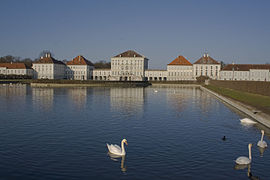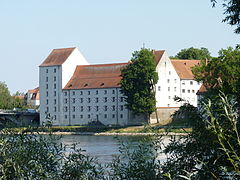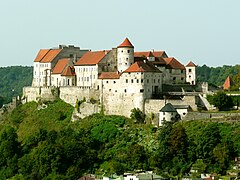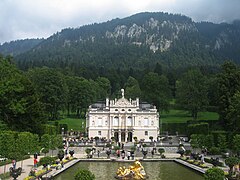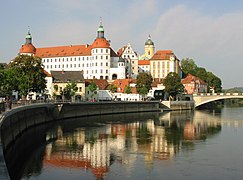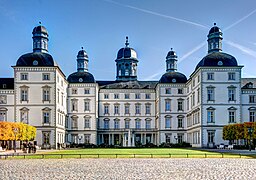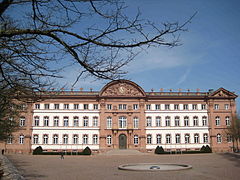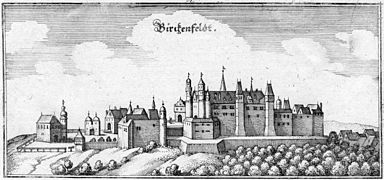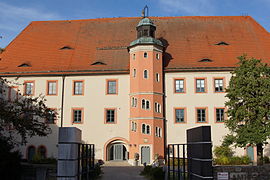Wittelsbach



The Wittelsbach house is one of the oldest German noble families . For centuries the Count Palatinate , the later dukes, electors and kings of Bavaria (1180–1918), as well as the Count Palatine of the Rhine (1214–1803 and 1816–1918), who as rulers of the Electoral Palatinate were already Electors of the Holy Roman Empire were.
Two Wittelsbachers were elected Roman-German emperors (1328 and 1742) and one Roman-German king (1400). Other territories of the Holy Roman Empire that were temporarily ruled by members of the house were the Electorate of Cologne (1583–1761), the Duchy of Jülich-Berg (1614–1794 / 1806), the Duchy of Liège , and the Margraviate of Brandenburg (1323–1373 ), the counties of Tyrol (1342–1363 / 1369) and Holland , Hainaut and Zealand (1345–1432) and the Duchy of Bremen-Verden (1654–1719). Twice, in 1619 and 1742, Wittelsbachers were anti -kings in Bohemia .
As one of the most important dynasties in Europe, they temporarily provided the kings of Hungary (1305), Sweden (1441–1448 and 1654–1720), Denmark and Norway (1440) and Greece (1832–1862).
origin
The exact origin of the Wittelsbach family is unclear. Legends lead them back to Charlemagne or even to ancient Trojans . A more plausible thesis says that the Wittelsbachers came from a sideline of the Luitpoldinger , named after Margrave Luitpold of Bavaria († 907). The theory, which is also most widely observed today by members of the Wittelsbach family and many scientists, is based on the genealogy of Otto Freiherr von Dungern , published in Austria in 1931 , in which the history of the family around the year 1000 with a Count Otto I. von Scheyern ( Otto comes de Skyrum ) begins.
The Luitpoldinger as the origin of the Wittelsbach family
Luitpold's son, Arnulf the Evil , was even elected German (counter) king in 919, but eventually submitted to Heinrich of Saxony and contented himself with the Duchy of Bavaria .
After Arnulf's death in 937, King Otto I granted the duchy to Arnulf's brother Berthold in 938 . Otto I also married his brother Heinrich to Arnulf's daughter Judith and thus established Heinrich's later claim, who after Berthold's death became Duke of Bavaria, disregarding the claims of other Luitpoldingen.
Arnulf's eldest son, Eberhard , had been deposed as duke in 938; the younger, Arnulf (II.) , became Count Palatine in Bavaria, built Scheyern Castle in 940 , and his descendants named themselves Counts of Scheyern after this castle .
The origin of the Wittelsbach family according to the genealogy Otto Freiherr von Dungern
According to the genealogy of Otto Freiherr von Dungern, published in 1931, the Wittelsbach family descends from Count Otto I von Scheyern , who is mentioned in documents in 1000 as Otto comes de Skyrum . The assured history of the Wittelsbach family begins with his son, Otto II von Scheyern .
The early Wittelsbachers until 1253
The Counts of Scheyern, Count Palatine of Bavaria
The Counts of Scheyern were:
- Otto I. von Scheyern (around 1014), ∞ (I) sister of Count Meginhard von Reichersbeuern, ∞ (II) widowed Countess Haziga
- Otto II of Scheyern (* ?; † 1120)
- Eckhard I. von Scheyern (* ?; † after 1101)
- Otto V. von Scheyern (*?; † 1156), Count Palatine of Bavaria
- Count Otto VIII von Scheyern (around 1117–1183) = Count Otto V. von Wittelsbach = Count Palatine Otto VI. of Bavaria = Duke Otto I of Bavaria / Wittelsbach (from 1180)
The bearers of the name Otto that are missing in the census are on the sidelines of the Counts Scheyern-Valley and von Scheyern-Dachau: → Konrad I. von Valley and Konrad I. von Dachau
Count Otto II von Scheyern is thus the great-grandfather of Count Otto VIII von Scheyern, who is called Count Otto V von Wittelsbach or Duke Otto I von Bayern according to a different way of counting.
Count Otto IV, Count of Scheyern moved in 1124 the residence of the Palatine from the Castle Scheyern after the Wittelsbach Castle in Aichach (now administrative region of Swabia).
Dukes of Merania (1153–1180 / 82)
Konrad II. Of Scheyern-Dachau, a son of Count Conrad I of the Dachau line of Wittelsbach, was in 1153 when Konrad I Duke of Meran . He was the first of the Wittelsbach family to receive a ducal office. In 1159 he was followed by his son Konrad II.
Dukes of Bavaria (1180–1253)
- 1180–1183: Duke Otto I von Wittelsbach (around 1117–1183), son of Otto V. von Scheyern
- 1183–1231: Ludwig I der Kelheimer (1173–1231), son of Otto I.
- 1231–1253: Otto II. (1206–1253) the illustrious, son of Ludwig I.
Otto VI. Count Palatine of Bavaria, who had distinguished himself on Frederick I Barbarossa's Italian campaigns, received the Duchy of Bavaria after the deposition of Heinrich the Lion in 1180 , whereupon he called himself Otto I of Wittelsbach, Duke of Bavaria. His son Ludwig I the Kelheimer was enfeoffed in 1214 with the Palatinate Countess near Rhine . Through his marriage in 1204 with Ludmilla, widow of Count Albert III. von Bogen , after the Bogen's ruling line had expired in 1242, the county of Bogen and its white-blue diamond coat of arms went to the Wittelsbach family. His son Otto II was betrothed to the Welfin Agnes, the niece of Emperor Otto IV, daughter of the Count Palatine Heinrich des Langen and thus heiress of the Palatinate, in 1212 at the age of 6 . The golden lion on a black background came to Bavaria as a heraldic animal, probably due to the later marriage, which was certainly concluded before 1224. Both in the Duchy of Bavaria and in the Electoral Palatinate, the Wittelsbachers succeeded the Guelphs as rulers.
A nephew of Otto I, Count Palatine Otto VIII von Wittelsbach , became notorious after the murder of King Philip of Swabia in 1208; he was ostracized and slain in 1209, and the ancestral castle Wittelsbach was destroyed by Duke Ludwig I.
After Otto II's death in 1255, the lines of Lower Bavaria and Upper Bavaria with the Palatinate were established between his sons . Both princes continued to carry the title Duke of Bavaria and Count Palatine of the Rhine.
Count Palatine near Rhine (1214–1253)
- 1214–1231: Ludwig I der Kelheimer (1173–1231), son of Otto I.
- 1231–1253: Otto II the illustrious (1206–1253), son of Ludwig I.
Two years after Otto's death, the first division of the country took place in 1255 under his sons Ludwig and Heinrich.
Lower Bavarian line 1253-1340
Dukes of Lower Bavaria (1255-1340)
- 1253–1290: Heinrich XIII. = Heinrich I of Lower Bavaria (1255–1290)
- 1290-1312: Otto III. (1261–1312), 1305–1308 also King of Hungary
- until 1296: together with Ludwig III.
- until 1310: together with Stephan I.
- 1310–1312: together with Otto IV. And Heinrich XIV. (The sons of Stephan I.)
- 1312–1339: Heinrich XIV. = Heinrich II. Of Lower Bavaria
- jointly / partially shared with Otto IV. (until 1334) and Heinrich XV. (Son of Otto III.) (Until 1333) = Heinrich III. from Lower Bavaria (= the Natternberger)
- 1339–1340: Johann I (son of Heinrich XIV.)
King of Hungary (1305-1308)
- 1305-1308: Otto III. (as Béla V.)
In 1305, the Lower Bavarian duke and son of a Hungarian king's daughter Otto III. proclaimed King of Hungary as Bela V. However, within a short time (1307) he was forced to hand over this crown to the Hungarian prince Ladislaus Apor .
With the deaths of Stephen I and Otto III in quick succession. their sons were still immature, so that their guardianship was claimed by various rulers. These included the Upper Bavarian Duke Ludwig IV of Bavaria and the Austrian Habsburgs. However, they were defeated in the battle of Gammelsdorf by Ludwig IV. The Bavarian, so that he took over the guardianship.
From the heirs Heinrich XIV ruled from Landshut over Straubing, Schärding and Pfarrkirchen, Otto IV from Burghausen over Ötting, Traunstein, Reichenhall and Rosenheim, Heinrich XV. but from the Natternberg near Deggendorf via Deggendorf, Landau, Dingolfing and Vilshofen. After the brothers all died between 1333 and 1339, the eleven-year-old son of Heinrich XIV, Johann I, took over the rule, but also died in December 1340. Lower Bavaria fell to Ludwig the Bavarian and was united with Upper Bavaria.
Upper Bavarian line 1253-1340
Count Palatine near Rhine (1253–1317)
- 1253–1294: Ludwig II. The Strict (1229–1294), son of Otto II.
- 1294–1317: Rudolf I the Stammler (1274–1319), son of Ludwig II.

Dukes of Upper Bavaria (1255-1340)
- 1253–1294: Ludwig II. The Strict (1229–1294)
- 1294–1317: Rudolf I the Stammler (1274–1319)
- 1294–1347: Ludwig IV the Bavarian (1282–1340), Roman-German King since 1314 , Emperor of the Holy Roman Empire since 1328 , Duke of all of Bavaria since 1340
With the house contract of Pavia in 1329, the Upper Bavarian line was divided into the older Palatinate line and the younger Bavaria .
The (Upper) Bavarian line ascended twice, with Ludwig IV. The Bavarian (1314-1346) and Charles VII. (1742-1745), the imperial throne , obtained the electoral dignity in 1623 under Maximilian I , but expired in 1777 with Maximilian Joseph . It was inherited by the Palatinate line, which once provided the German king with Ruprecht von der Pfalz.
Roman-German kings and emperors

- 1314–1347: Ludwig IV. The Bavarian
- 1400–1410: Ruprecht von der Pfalz
- 1742–1745: Charles VII. Albrecht
Bavarian line 1340–1777
Dukes of Bavaria (1340-1349)
- 1340–1347: Ludwig IV. The Bavarian
- 1347-1349 the six sons of Emperor Ludwig, Ludwig V , Stephan II. , Ludwig VI ruled . , Wilhelm I. , Albrecht I. and Otto V. together; after that their possessions were divided into Upper Bavaria-Tyrol and Brandenburg, Lower Bavaria-Landshut and Lower Bavaria-Straubing-Holland-Hainaut.
Dukes of Upper Bavaria and Counts of Tyrol and Margraves of Brandenburg (1349–1363 / 1373)
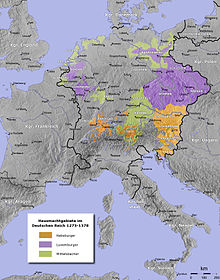
- 1347–1361 Ludwig V , from 1342 also Count of Tyrol and 1322–1351 Margrave of Brandenburg
- 1347–1351 Ludwig VI. der Römer , 1351–1364 / 1365 Margrave and Elector of Brandenburg
- 1347–1351 Otto V. der Lazy , 1351–1373 (de jure) and 1364 / 1365–1371 (de facto) Margrave and Elector of Brandenburg
- 1361–1363 Meinhard , also Count of Tyrol, his territory fell to Stephan II after his death.
Dukes of Bavaria-Straubing and Counts of Holland, Zealand, Hainaut (1353–1425 / 1429)
- 1347–1388 Wilhelm I , also ruled as Count of Holland, Zealand and Hainaut ( incapable of government since 1357 )
- 1347–1404 Albrecht I and Albrecht II † 1397, also ruled as Counts of Holland, Zealand and Hainaut
- 1404–1417 Wilhelm II , also Count of Holland, Zealand and Hainaut
- 1404-1425 John III. , also Count of Holland, Zealand and Hainaut, after him Straubing was divided into the remaining lines of Munich, Landshut and Ingolstadt
Dukes of Lower Bavaria-Landshut (1353-1392)
- 1347–1375 Stephan II.
- 1373–1379 Otto V.
In 1392 the three sons of Stephen II, who previously ruled together, were again divided into Bavaria-Munich , Bavaria-Landshut and Bavaria-Ingolstadt
Dukes of Bavaria-Ingolstadt (1392–1447)
- 1375-1413 Stephan III. (Father of Queen Isabeau of France)
- 1413–1447 Louis VII the Bearded
- 1438–1445 Ludwig VIII the Younger , in 1447 the duchy came to Bavaria-Landshut
Dukes of Bavaria-Landshut (1392–1503)
- 1375-1393 Friedrich , the way
- 1393–1450 Heinrich XVI. , the rich
- 1450–1479 Louis IX. , the rich
- 1479-1503 Georg , the rich , 1505 came the duchy of Bayern Munich.
Dukes of Bavaria-Munich (1392–1505)
- 1375–1397 Johann II.
- 1397–1438 Ernst
- 1397-1435 Wilhelm III.
- 1435–1441 Adolf
- 1438–1460 Albrecht III. , the pious one
- 1460–1463 Johann IV.
- 1460–1467 Siegmund , then Duke of Bavaria-Dachau
- 1465–1508 Albrecht IV , the Wise , united all Bavarian lines in 1503
Dukes of Bavaria (1505–1623)

- 1505–1508 Albrecht IV , the Wise , united all Bavarian lines in 1503
- 1508–1550 William IV.
- 1508–1545 Ludwig X. in Landshut
- 1550–1579 Albrecht V , the Magnanimous
- 1579–1598 Wilhelm V , the Pious
- 1598–1651 Maximilian , already co-regent of his father Wilhelm since 1597; During the Thirty Years' War, the Elector was transferred from the Count Palatine to the Bavarian Duke by the Emperor . In the Peace of Westphalia in 1648 Bavaria was confirmed as an electorate, so that Maximilian became the first Bavarian elector.
Elector of Bavaria (1623–1777)
On February 25, 1623, Duke Maximilian I of Bavaria received the Palatinate electoral dignity.

- 1623–1651 Maximilian I , already Bavarian Duke since 1597, in 1623 the Palatinate electoral dignity passed to him and in 1648 the Upper Palatinate came to Bavaria.
- 1651–1679 Ferdinand Maria , ruled in the early years under the tutelage of his mother Maria Anna .
- 1679–1726 Maximilian II Emanuel , also Governor General of the Netherlands (1692–1706) and Duke of Luxembourg (1712–1714)
- 1726–1745 Karl Albrecht , 1741–1743 also King of Bohemia, from 1742 as Charles VII also Emperor of the Holy Roman Empire
- 1745–1777 Maximilian III. Joseph
The Bavarian line of the Wittelsbach family died out in 1777. It was followed by Karl Theodor on the Pfalz-Sulzbach line , which already ruled over the Electoral Palatinate . After the death of Karl Theodor in 1799, the dukes of Zweibrücken received the electoral dignity.
King of Bohemia (1741–1743)
- 1741–1743 Karl Albrecht , from 1742 as Charles VII also Emperor of the Holy Roman Empire
Elector of Cologne (1583–1761)
From 1583 to 1761, the Bavarian princes of Wittelsbach occupied the Cologne Erzstuhl and numerous other dioceses.
- Ernst of Bavaria 1583–1612
- Ferdinand of Bavaria 1612–1650
- Maximilian Heinrich of Bavaria 1650–1688
- Joseph Clemens of Bavaria 1688–1723
- Clemens August I of Bavaria 1723–1761

Prince-Bishops of Liège (1389–1418 / 1581–1763)
- Johann VI. from Straubing-Holland 1389-1418
From 1581 to 1763, Wittelsbach princes from the curbs occupied the chair of the duchy of Liège almost continuously .
- Ernst of Bavaria 1581–1612
- Ferdinand of Bavaria 1612–1650
- Maximilian Heinrich of Bavaria 1650–1688
- Joseph Clemens of Bavaria 1694–1723
- Johann Theodor of Bavaria 1744–1763
Palatinate line 1317–1806
Count Palatine near Rhine (1317–1356)
- 1317–1327: Adolf the Honest (1300–1327), son of Rudolf I.
- 1329–1353: Rudolf II. The Blind (1306–1353), son of Rudolf I.
- 1353–1390: Ruprecht I the Red (1309–1390), son of Rudolf I, 1356 elector of the Palatinate
The first Count Palatine of the again independent Palatinate was Rudolf I in 1317 he renounced it in favor of his brother Emperor Ludwig IV. His son Rudolf II came back in 1329 in possession of the paternal hereditary lands. With the Golden Bull of Emperor Karl IV., The Count Palatinate near Rhine received the electoral dignity from Charles IV in 1356 .
Electoral Palatinate with divisions (1356–1777)



The Palatinate line of the Wittelsbach family received the electoral dignity under Ruprecht I in 1356. In the same year, in execution of the legacy of his brother and predecessor Rudolf II , he donated the Liebfrauenstift Neustadt an der Weinstrasse , as a memorial of his house. Here he and his brother Rudolf II and 3 Palatine rulers were buried. There were anniversaries to be celebrated there for a total of 13 Wittelsbach princes and their wives. In 1386, Elector Ruprecht I founded Heidelberg , the third German university .
Ruprecht III. von der Pfalz was elected Roman king (1400–1410) by the Rhenish electors , but only recognized in part of the empire.
After his death, the Palatinate line was divided into the four lines Kurpfalz ( Heidelberg ), Pfalz-Neumarkt (expired 1443), Pfalz-Simmern and Pfalz-Mosbach-Neumarkt (expired 1499).
The line Pfalz-Neumarkt provided with Christoph III. 1440–1448 the king of Denmark, Sweden and Norway. The Heidelberg line died out in 1559 with Ottheinrich , followed by the reformed Pfalz-Simmern line.
Elector Friedrich V of the Palatinate was elected King of Bohemia in 1619. After losing the battle on White Mountain , he fled to Holland. The Palatinate cure was transferred to Bavaria in 1623. In 1648 two new cures were created, one of which was given to the Palatinate.
The Pfalz-Simmern line expired in 1685 with Karl II, Liselotte's brother of the Palatinate. This was followed by the Pfalz-Neuburg line , which was detached from the Zweibrücken line in 1569 and acquired Jülich and Berg in 1614 ; This was followed by the Pfalz-Sulzbach line, which has been independent since 1614 .
Heidelberg Kurline
- Ruprecht I , Elector Palatinate 1353 / 54–1390
- Ruprecht II , Elector Palatinate 1390–1398
- Ruprecht III. , Elector of the Palatinate 1398–1410, 1400–1410 also Roman king
- Ludwig III. , Elector Palatinate 1410–1436
- Ludwig IV. , Elector Palatinate 1436–1449
- Friedrich I the Victorious, Elector Palatinate 1452–1476
- Philip the Sincere , Elector Palatinate 1476–1508
- Ludwig V , Elector Palatinate 1508–1544
- Friedrich II. , Elector Palatinate 1544–1556
- Ottheinrich , Elector Palatinate 1556–1559
Palatinate-Simmern
- Friedrich III. , Elector Palatinate 1559–1576
- Louis VI. , Elector Palatinate 1576–1583
- Friedrich IV. , Elector Palatinate 1583–1610
- Friedrich V , Elector Palatinate 1610–1623 and King of Bohemia (1619–1620)
In 1623 the Palatinate lost its electoral dignity to the Bavarian Duke Maximilian I , who had expelled Friedrich V from Bohemia. With the Peace of Westphalia , an eighth cure was created for the restituted Electoral Palatinate. The Palatinate-Simmern Calvinist line only ruled there until the death of Charles II in 1685.
- Karl I. Ludwig , Elector Palatinate 1649–1680
- Karl II , Elector Palatinate 1680–1685, last of the Palatinate-Simmern line
Pfalz-Neuburg
- Philipp Wilhelm , Elector Palatinate 1685–1690, from the Palatinate-Neuburg line that has been reconverted to Catholicism
- Johann Wilhelm , Elector Palatinate 1690–1716
- Charles III Philipp , Elector Palatinate 1716–1742
Pfalz-Sulzbach
- Karl IV. Philipp Theodor , Elector Palatinate 1743–1777, 1777–1799 after the extinction of the Bavarian Wittelsbachers also Elector of Bavaria
King of Denmark, Sweden and Norway (1440–1448)
- Christopher III. (1440-1448)
King of Bohemia (1619-1620)
- Friedrich V , Elector Palatinate 1610–1623 and King of Bohemia (1619–1620)
Kings of Sweden (1654–1720) and Dukes of Bremen-Verden (1654–1719)

After the death of King Rupprecht in 1410, the Simmern-Zweibrücken line was created, which split into the Simmern-Sponheim and Zweibrücken-Veldenz line in 1444.
Through the Pfalz-Zweibrücken- Kleeburg line, the Palatinate Wittelsbachers had again from 1654 to 1720 - after Christoph III. (1440–1448) - holds the Swedish throne.
- Charles X Gustav 1654-1660
- Charles XI. 1660-1697
- Charles XII. 1697-1718
- Ulrike Eleonore 1718-1720
Abbess of Essen Abbey (1726–1776)
- (Imperial sovereign ruler)
- Franziska Christine von Pfalz-Sulzbach 1726–1776
Dukes of Jülich and Berg (1614–1806)
As a result of the Treaty of Xanten, from 1614 the line from Pfalz-Neuburg also held the duchies of Jülich and Berg , which were combined to form Jülich-Berg and were ruled from Düsseldorf .
- Wolfgang Wilhelm (1614–1653)
- Philipp Wilhelm (1653–1679) also Elector Palatinate 1685–1690
- Johann Wilhelm (1679–1716), also Elector Palatinate 1690–1716
- Charles III Philipp , also Elector Palatinate 1716–1742
- Karl IV. Philipp Theodor , also Elector Palatinate 1743–1799 and Bavaria 1777–1799
- Maximilian I. Joseph (1799–1806), also Elector of Palatinate Bavaria
Dukes of Zweibrücken (1410–1797)
The last Duke of Zweibrücken was Maximilian Joseph, Duke without a Land, in 1795. The French revolutionary troops had occupied the duchy at this time. In 1799 he succeeded Karl Theodor as elector in Munich.
Elector of Palatinate Bavaria (1777–1806)
- Karl Theodor (1777–1799), Pfalz-Sulzbach line
- Maximilian IV Joseph (1799–1806), Pfalz-Birkenfeld line , from 1806 as Maximilian I Joseph King of Bavaria.
Palatinate line since 1806
Kings of Bavaria (1806-1918)

After the Pfalz-Sulzbach line died out in 1799, Maximilian IV (Pfalz-Zweibrücken-Birkenfeld-Bischweiler) succeeded Karl Theodor. In 1806 he became King of Bavaria , thus establishing the line of kings that ruled in the November Revolution of 1918 until it was deposed just before the end of the First World War . The royal line includes:
- Maximilian I. Joseph (1806-1825)
- Ludwig I (1825–1848)
- Maximilian II (1848–1864)
- Ludwig II. (1864-1886)
- Prince Regent Luitpold (1886-1912), regent for Ludwig II. , And then also for Otto I .
- Otto (1886-1916)
- Ludwig III. initially as Prince Regent (1912–1913) and, after the constitution was amended, as King (1913–1918).
The house order of the Wittelsbacher is the order of George founded in the 12th century and restored in 1729 .
Max I. Joseph (1806-1825)
Ludwig I (1825–1848)
Maximilian II (1848–1864)
Ludwig II. (1864-1886)
Prince Regent Luitpold (1886–1912)
Ludwig III. (1913-1918)
King of Greece (1832–1862)

Due to the descent from the Byzantine House of Komnenos and the House of Laskaris , the Greek National Assembly appointed the House of Wittelsbach to the throne of liberated Greece.
- Otto I. (1832–1862) ( abdication after uprising)
Heads of the House of Wittelsbach (after 1918)

- Ludwig III. (1918–1921)
- Rupprecht of Bavaria (1921–1955)
- Albrecht of Bavaria (1955–1996)
- Franz von Bayern (since 1996)
After the deposition of Ludwig III. During the November Revolution of 1918, he temporarily emigrated abroad with his family. In the Anifer Declaration, the king released the officials from their oaths of office on him. On the other hand, neither he nor later Wittelsbachers ever renounced the throne.
In the course of the division of state and household assets, the Wittelsbach Compensation Fund was set up by a compromise in 1923 and the Wittelsbach State Foundation for Art and Science was established by the former Crown Prince Rupprecht of Bavaria . The Wittelsbach State Foundation received the art treasures acquired by the Wittelsbach family before 1804 and has since been the owner, if not the administrator, of a large part of the holdings of the Munich museums, while more recent art collections came into the possession of the compensation fund. In 1923, some properties from the Wittelsbachers' former household property - Fideikommiss - were brought into the compensation fund , including the Berg castles , Hohenschwangau (including the Museum of the Bavarian Kings established in 2011 ), Berchtesgaden and Grünau .
Wittelsbach's private assets include the castles Tegernsee , Wildenwart , Leutstetten and Kaltenberg as well as agriculture and forestry with an area of 12,500 hectares, real estate and industrial shares .
Dukes in Bavaria
Duke in Bavaria was since 1799 the title of the branch Pfalz-Zweibrücken -Birkenfeld-Gelnhausen of the Bavarian-Palatinate ruling house of the Wittelsbacher, beginning with Wilhelm in Bavaria . Her descendants were Elisabeth (Sisi), wife of Emperor Franz Joseph of Austria-Hungary. The surname Herzog has currently lived on in Bavaria since Ludwig Wilhelm Herzog adopted his great-nephew Max Emanuel Prince of Bavaria in Bavaria on March 18, 1965 .
List of Wittelsbach lines
Bavarian lines
| Bavaria first division in 1255 | |||||||||||||||
| Upper Bavaria older line | Lower Bavaria older line, until 1340 | ||||||||||||||
| Division 1349 | |||||||||||||||
|
Upper Bavaria younger line, until 1363/79 |
Lower Bavaria younger line, division 1353 | ||||||||||||||
| Lower Bavaria-Landshut |
Niederbayern-Straubing expires in 1425, inheritance split in 1429 |
||||||||||||||
| Division 1392 | |||||||||||||||
| Bayern Munich | Bavaria-Ingolstadt | Bavaria-Landshut | |||||||||||||
| Pressburger | Arbitration | saying | |||||||||||||
| 1447 inherited by Bavaria-Landshut | |||||||||||||||
| Inherited by Bayern-Munich in 1503/5 | |||||||||||||||
| 1777 inherited from Pfalz-Sulzbach | |||||||||||||||
Further lines (derived directly or indirectly from the older Upper Bavarian line)
- Palatinate
- Kurlinie Heidelberg
- Mosbach
- Mosbach-Neumarkt
- Simmern-Zweibrücken
- Pfalz-Simmern - Sponheim
- Pfalz-Lützelstein
- Pfalz-Veldenz-Lützelstein
- Palatinate-Neumarkt
- Pfalz-Neuburg-Hilpoltstein
- Pfalz-Neuburg
- Palatinate-Sulzbach II
- Pfalz-Sulzbach-Hilpoltstein
- Pfalz-Zweibrücken
- Zweibrücken Landsberg
- Zweibrücken Kleeburg
- Pfalz-Sulzbach I (Hilpoltstein)
- Pfalz-Parkstein
- Pfalz-Birkenfeld
- Pfalz-Zweibrücken-Birkenfeld
- Palatinate-Birkenfeld-Bischweiler
- Pfalz-Birkenfeld-Gelnhausen
Morganatic and extramarital descendants
- Prince of Bretzenheim
- Barons von Fürstenwarther
- Barons of Hegnenberg-Dux
- Counts of Holnstein from Bavaria
- Princes of Löwenstein-Wertheim
- Karoline Franziska Dorothea von Parkstein
- Raugrafen zu Pfalz
- Joseph Ferdinand Maria von Salern
- by Plottnitz-Stockhammer
- from Wallersee
- Counts of Wartenberg
- Baron von Zweybrücken
- Baron Ludwig von Stein
Wittelsbach castles
Bavaria
Some of the most important Bavarian castles, which were built by Wittelsbach rulers or served as the seats of ruling lines, were:
The old court in Munich
Nymphenburg Palace in Munich
Schleissheim Palace in Oberschleißheim near Munich
Trausnitz Castle in Landshut
Palatine line
The most important seats of the Palatinate Wittelsbachers were:
Heidelberg Castle 1670
Benrath Palace in Düsseldorf
Birkenfeld Castle 1645
Simmern Castle 1648
Kurköln
From 1597 to 1794, Bonn was the residence of the Electorate of Cologne , whose electors and archbishops came from the Bavarian line of the House of Wittelsbach from 1583 to 1761.
Augustusburg Castle in Brühl
Burial places
- Scheyern : Scheyern Monastery (Johanneskirche of the former ancestral castle, today's choir chapel, first and oldest Wittelsbach burial place)
- Landshut : Seligenthal Abbey ( Seligenthal abbey church, burial place of the dukes of Lower Bavaria and Bavaria-Landshut, looted and devastated in the Thirty Years War)
- Andechs : Andechs Monastery (on the Holy Mountain of Bavaria, today's burial place of all Wittelsbachers)
- Munich : Michaelskirche , Theatinerkirche , Abbey St. Bonifaz , Frauenkirche
- Altötting : Gnadenkapelle (heart burial place)
- Fürstenfeldbruck : Fürstenfeld Monastery
- Neustadt an der Weinstrasse : Collegiate Church
- Darmstadt : Evangelical City Church (Princely Crypt)
- Düsseldorf : St. Andrew's Church , mausoleum, a. a. Magnificent sarcophagus Jan Wellems
- Heidelberg : Heiliggeistkirche (formerly 54 tombs and coffins of Electors of the Palatinate who were buried between 1410 and 1685 and of members of the electoral families); Carmelite Church Heidelberg (formerly ten graves, demolished, all Wittelsbachers transferred to St. Michaelskirche Munich in 1805); Jesuit Church Heidelberg , (burial place of Elector Friedrich I of the Palatinate )
- Ingolstadt : Munster for the Beauty of Our Lady (Wittelsbach burial place)
- Mannheim : castle church , crypt chapel, (sarcophagus of Elector Karl III. Philip and his wife)
- Meisenheim : castle church , Wittelsbacher burial chapel, numerous graves
- Zweibrücken : Alexander Church , numerous Wittelsbach graves
- Tegernsee : Tegernsee monastery church , Wittelsbach crypt, burial place of the dukes in Bavaria
- Großheubach : Franciscan monastery Engelberg , crypt chapel of the princes of Löwenstein
- Simmern : Stephanskirche , graves of the Pfalz-Simmern line
See also
- Wittelsbach family list
- List of German noble families
- List of the rulers of Bavaria , List of the rulers of the Electoral Palatinate
- War of the Bavarian Succession
literature
- Genealogy of the House of Wittelsbach . Administration of the Duke of Bavaria (Nymphenburg Palace), Munich 1996.
- Adalbert Prince of Bavaria : The Wittelsbacher. History of our family . 2nd edition, Prestel, Munich 1980, ISBN 3-7913-0476-3 .
- Ludwig Holzfurtner: The Wittelsbacher. State and dynasty in eight centuries. Kohlhammer, Stuttgart 2005, ISBN 3-17-018191-2 . ( Review )
- Hans-Michael Körner : The Wittelsbacher. From the Middle Ages to the present. Beck, Munich 2009, ISBN 978-3406562587
- Britta Kägler , Michael Hecht: Dynasties and high nobility: The Anhalt Ascanians / The Bavarian Wittelsbachers , in: Werner Freitag, Michael Kißener, Christine Reinle, Sabine Ullmann, Sabine (eds.): Handbuch Landesgeschichte , Berlin 2018, pp. 268-302.
- Hans F. Nöhbauer : The Wittelsbacher - A European dynasty-a German chronicle. Moewig, Gütersloh 1979, ISBN 3-8118-3120-8 .
- Jörg Peltzer , Bernd Schneidmüller , Stefan Weinfurter , Alfried Wieczorek (eds.): The Wittelsbachers and the Electoral Palatinate in the Middle Ages. A success-story? Schnell + Steiner, Regensburg 2013, ISBN 978-3-7954-2645-3 .
- Hans Rall , Marga Rall: The Wittelsbacher in life pictures. Piper, Munich 2005, ISBN 3-492-24597-8 .
- Christian Dickinger: The black sheep of the Wittelsbacher. Between throne and madness. Piper, Munich 2005.
- Volker Press : The House of Bavaria. In: Yearbook of the Historical Association for the Principality of Liechtenstein 93 (1995), pp. 141–186
- Herbert Eulenberg : The last Wittelsbacher. Phaidon, Vienna 1929.
Web links
- www.Gen.Heinz-Wember.de/Wittelsbacher - The genealogy of the Wittelsbacher
- www.Haus-Bayern.com - House of Bavaria, Wittelsbacher compensation fund
- Gerhard Immler , Wittelsbacher (19th / 20th century), in: Historisches Lexikon Bayerns
- Special exhibition The Wittelsbachers and the Middle Kingdom. 400 years of China and Bavaria in the Bavarian National Museum in Munich, until July 26, 2009
- Special exhibition Die Wittelsbacher am Rhein in the Museum Zeughaus and Baroque Palace Mannheim, September 8, 2013 to March 2, 2014












